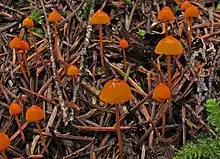| Mycena strobilinoides | |
|---|---|
 | |
| Scientific classification | |
| Domain: | Eukaryota |
| Kingdom: | Fungi |
| Division: | Basidiomycota |
| Class: | Agaricomycetes |
| Order: | Agaricales |
| Family: | Mycenaceae |
| Genus: | Mycena |
| Species: | M. strobilinoides |
| Binomial name | |
| Mycena strobilinoides Peck (1893) | |
| Synonyms[1] | |
Mycena strobilinoides, commonly known as the flame mycena,[4] or scarlet fairy helmet, is a species of agaric fungus in the family Mycenaceae. It is found in North America, where it fruits scattered or in dense groups on needle beds and moss.[5] The mushroom is more common in western than eastern North America, and is also present in Europe.[6] It prefers to grow at elevations greater than 2,500 feet (760 m) in montane locales. It has amyloid, ellipsoid spores measuring 7–9 by 4–5 μm.[1]
The fruit bodies are bright orange, most intensely on the edge of the gills. The stem is covered with long orange hairs.[6]
References
- 1 2 Smith AH. (1947). North American Species of Mycena. Ann Arbor, Michigan: University of Michigan Press.
- 1 2 Murrill WA. (1916). "Agaricaceae Tribe Agariceae". North American Flora. 9 (5): 297–374.
- ↑ Murrill WA. (1916). "Pleurotus, Omphalia, Mycena, and Collybia published in North American Flora". Mycologia. 8 (4): 218–21. doi:10.2307/3753527. JSTOR 3753527.
- ↑ Thiers, Harry D.; Arora, David (September 1980). "Mushrooms Demystified". Mycologia. 72 (5): 1054. doi:10.2307/3759750. ISSN 0027-5514.
- ↑ McKnight VB, McKnight KH. (1987). A Field Guide to Mushrooms: North America. Peterson Field Guides. Boston, Massachusetts: Houghton Mifflin. p. 176. ISBN 0-395-91090-0.
- 1 2 Trudell, Steve; Ammirati, Joe (2009). Mushrooms of the Pacific Northwest. Timber Press Field Guides. Portland, OR: Timber Press. pp. 129–130. ISBN 978-0-88192-935-5.
External links
| Mycena strobilinoides | |
|---|---|
| Gills on hymenium | |
| Cap is campanulate or conical | |
| Hymenium is adnate or decurrent | |
| Stipe is bare | |
| Spore print is white | |
| Ecology is saprotrophic | |
| Edibility is unknown | |
This article is issued from Wikipedia. The text is licensed under Creative Commons - Attribution - Sharealike. Additional terms may apply for the media files.